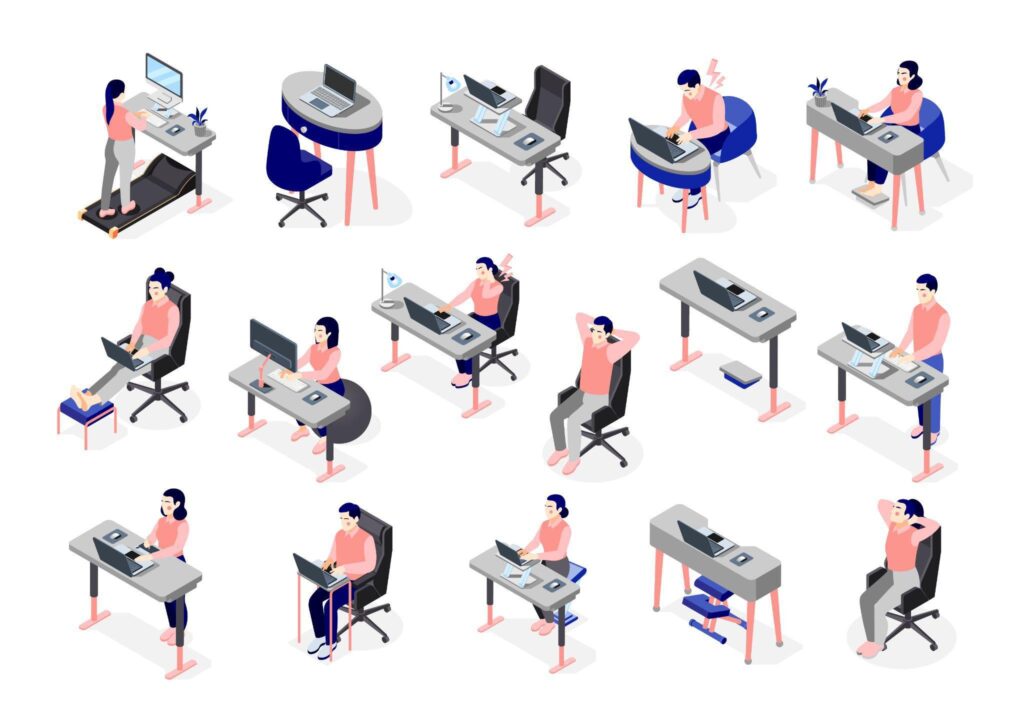In today’s dynamic work landscape, the convergence of technology and evolving work practices has revolutionized the way we operate within office environments. However, amidst the efficiency and convenience, a prevalent challenge looms large—back pain among office workers. Prolonged hours spent at desks, coupled with sedentary work habits and suboptimal workstation setups, often contribute to discomfort and musculoskeletal issues, prominently centered around the back.
The burgeoning concern of back pain necessitates a profound understanding and integration of office ergonomics. This multifaceted approach not only addresses the immediate discomfort but also serves as a linchpin in nurturing a workplace environment that prioritizes holistic health and sustains peak employee performance.
Improve on efficiency by these simple techniques.
The Implications of Sedentary Work on Back Health
Extended periods of sitting in inadequately designed workspaces can lead to various musculoskeletal issues, with back pain emerging as a predominant concern. This sedentary routine, coupled with poor posture and repetitive movements, strains the spine, muscles, and ligaments, resulting in discomfort and potential long-term health repercussions. Visit our Youtube Channel for techniques of improving office ergonomics.
An In-Depth Look into Key Ergonomic Components of Workstations
1. Chair Selection and Adjustment:
Fundamental to ergonomic support is choosing an adjustable chair with lumbar support. Proper height adjustments ensure feet rest flat on the floor with knees forming a 90-degree angle, providing optimal lower back support.
2. Desk and Monitor Alignment:
Setting desk heights for comfortable arm positioning at a 90-degree angle and adjusting monitors to eye level while positioned at an arm’s length significantly reduces strain on the neck and eyes.
3. Optimizing Keyboard and Mouse Placement:
Proximity of the keyboard and mouse to the body minimizes overreaching and maintains a relaxed wrist position while typing, and incorporating wrist rests aids in reducing strain during prolonged computer use.
4. Using Monitor and Document Holders:
Integrating document holders alongside monitors reduces neck strain caused by frequent transitions between documents and screens, promoting a more ergonomic workflow.
5. Lighting and Visual Comfort:
Ensuring sufficient lighting and minimizing screen glare play a pivotal role in reducing eye strain. Adjusting window shades or utilizing anti-glare screens enhances visual comfort during work hours.
Implementing Best Practices for Optimal Ergonomic Health
1. Scheduled Breaks and Movement:
Encouraging short breaks every 30-60 minutes facilitates movement, stretching, and brief walks. Incorporating targeted stretches for the back, neck, and shoulders relieves muscle tension and enhances flexibility.
2. Promoting Correct Posture:
Stressing the importance of maintaining proper posture—sitting with a straight back, relaxed shoulders, and firmly planted feet—diminishes the likelihood of slouching or excessive leaning forward.
3. Embracing Ergonomic Accessories:
Utilizing footrests, back cushions, or standing desks optimizes comfort and supports healthy posture throughout the workday.
4. Prioritizing Hydration and Nutrition:
Encouraging regular hydration and nutritious snacking sustains energy levels, preventing fatigue-induced poor posture, contributing to overall health and productivity.
Facilitating Ergonomic Integration in the Workplace
1. Educational Empowerment for Employees:
Providing comprehensive educational resources and training sessions on optimal ergonomics empowers employees to make informed choices and implement ergonomic adjustments effectively.
2. Systematic Ergonomic Assessments:
Conducting regular evaluations of workstations helps identify and rectify potential ergonomic challenges. Adjusting furniture, equipment, or introducing personalized ergonomic solutions mitigates risks associated with poor ergonomics.
3. Fostering a Culture of Movement and Flexibility:
Cultivating an environment that encourages movement, stretching, and flexibility exercises through scheduled breaks or workshops fosters employee well-being and productivity.
4. Investing in Ergonomic Solutions:
Prioritizing investments in ergonomic furniture and accessories creates a workspace that champions proper posture and back health, benefiting both employees and employers.
The Enduring Benefits of Embracing Ergonomic Principles
Adhering to ergonomic practices extends beyond alleviating back pain—it contributes to heightened employee well-being and productivity. Prioritizing ergonomic adjustments mitigates the risk of chronic back issues, leading to reduced absenteeism and curbed healthcare expenses for organizations.
Sustaining Employee Wellness Through Ergonomic Excellence
Office ergonomics stands as a beacon of hope in the realm of workplace well-being, offering a comprehensive approach to combat the pervasive issue of back pain among office workers. Throughout this exploration, we’ve delved into the intricate layers of ergonomic design, practices, and cultural integration within workspaces, understanding their pivotal role in sustaining employee health and performance.
The modern work landscape, driven by technological advancements and evolving work practices, demands a reevaluation of our approach to occupational health. Back pain, a prevalent concern stemming from prolonged seated tasks, finds an antidote in the conscientious application of ergonomic principles. By acknowledging the impact of sedentary work on back health, we lay the foundation for proactive solutions centered around ergonomics.
Ergonomic optimization, encapsulating tailored workstation setups and mindful practices, transcends the physical aspects of workspaces. It embodies a philosophy that prioritizes the well-being of employees—a commitment to fostering correct posture, reducing strain, and creating environments conducive to sustained back health.
Yet, the essence of office ergonomics extends beyond mere physical adjustments. It embodies a culture—a culture of movement, stretching, and mindful breaks that rejuvenate the body; a culture of advocating for correct posture and supporting employees in their pursuit of holistic health.
As organizations navigate the terrain of workplace wellness, the integration of ergonomic principles emerges as an investment—an investment in the health, satisfaction, and productivity of their workforce. By embracing ergonomic excellence, organizations not only address back pain but also pave the way for a resilient, engaged, and thriving workforce.
In the journey towards sustaining employee wellness, office ergonomics serves as a guiding light—a testament to the profound impact that intentional design, mindful practices, and a culture of health can have on the lives of those within the workplace. Let us continue to nurture ergonomic excellence, ensuring that our workspaces remain vibrant hubs of productivity and well-being.

